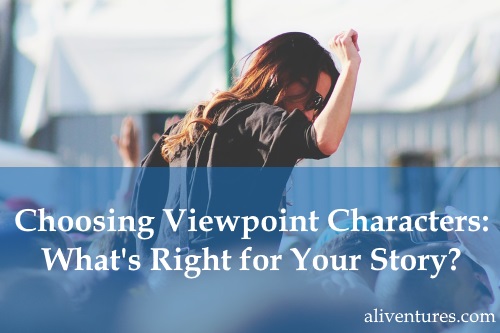Choosing Viewpoint Characters: What’s Right for Your Story?
 This post was first published in May 2017 and last updated in January 2025.
This post was first published in May 2017 and last updated in January 2025.
Sometimes, it’s obvious who the POV (point of view) character(s) will be for a particular story. Maybe you’re writing a first-person romance novella, for instance, with the heroine as the only viewpoint character.
But in many cases, there isn’t a clear-cut choice. You might have a main character plus other characters who play a big role in the story. Your protagonist will likely be one viewpoint character, but you may want others too.
When you sit down to write any new story, viewpoint (often called POV, for point of view) is pretty much the first decision you have to make. Who will begin your story? What other voices will you bring in? The decisions you make will shape the whole of your narrative … and they’ll shape the reader’s experience of it.
Choosing a POV Character: One Person … or More?
The simplest option is to stick with a single viewpoint character: this could be a first-person or third-person narrator.
If you have just one POV character, they’ll normally be the protagonist – though that’s not essential. Some older works in particular use a non-protagonist narrator: John Watson is the first-person narrator of the Sherlock Holmes stories – but Sherlock is the protagonist.
The advantages to having just one viewpoint character, whether first or third, are:
- It keeps things simple. You don’t need to make decisions on when to switch viewpoint, and head-hopping is less of a risk.
- The reader can be drawn quite quickly into the story: they don’t have to get to know multiple “voices” or sympathise with several different perspectives.
- You can keep information from the reader by keeping it from the viewpoint character: for instance, if you’re not showing the antagonist’s perspective, his/her plans can be easily kept secret.
If you have multiple POV characters, however:
- Readers can cope better with an annoying or self-absorbed point of view character as this isn’t the only perspective they’ll get.
- You can experiment with more unusual perspectives that might not be work if you used them for a whole novel.
- Your story can be more complex, both in terms of plot and theme: this suits some genres better than others, of course.
- You can show the reader what’s happening in multiple different locations at the same time: this could be important for the plot, or simply a way to highlight a particular point or theme.
- You can build up tension by letting the reader know something that the protagonist doesn’t (e.g. what the antagonist has planned).
There’s no “right” answer about how many characters’ perspectives to have, but it’s also important to think about how long your story is going to be.
If you’re writing a short story, you’ll probably want to stick to one viewpoint character (unless it’s essential for the plot that you have two different perspectives).
In a novella, you might find that two viewpoints work well – maybe in a split narrative – but you won’t want to have lots of different voices coming in.
In a full-length novel, you might have quite a few viewpoint characters: in Lycopolis, for instance, I have seven (and its sequel Oblivion has nine). You’ll need to think then about which characters get the main share of viewpoint scenes – some of mine only have a couple of chapters each as their perspectives aren’t so critical to the story.
And if you’re writing an epic Game of Thrones style fantasy, you could have a huge number of viewpoint characters: in the five books of A Song of Ice and Fire so far, there are 31 different viewpoint characters.
What if Your Story’s POV Isn’t Quite Working?
Sometimes, a story that doesn’t quite come together has a viewpoint issue.
You might feel a tension as you’re drafting: in Write a Novel and Get it Published, Nigel Watts mentions struggling with the draft of his novel Billy Bayswater, only for it to fall into place when he changed the narrative from third person into first person.
Or, you may get through your first draft but then feel – on re-reading – that the story simply isn’t as gripping as you’d hoped, or that one character’s scenes read far better than another’s.
Here are a few things to think about if you’re considering changing what POVs you use:
- More viewpoints are not necessarily going to make for a richer or more interesting story. Sometimes, keeping a particular perspective off the page makes for a better read – you might feel like you want to keep a character’s thought processes a bit mysterious. Novelist K.M. Weiland talks about this when she explains she chose to use Hitch’s viewpoint, not Jael’s, in Storming because she didn’t want to lose “the mystery and humor we get by viewing her from an outside.”
- On the other hand, sometimes an unusual perspective can breathe new life into a long story – in the Chaos Walking trilogy, I enjoyed the addition of Viola’s perspective in the second volume and the Spackle’s hive-mind viewpoint in the third.
- If the story feels too fragmented between different viewpoints, you may need to rein some in: that could mean that some characters no longer get viewpoint scenes at all, or simply that you reduce how many viewpoint scenes they have.
- As a writing exercise, it can be helpful to switch things around: maybe you could try rewriting a third person scene in the first person or a scene in past tense in the present tense. You may well decide that you’re not going to change it permanently – but it could help you nail down a particular character’s voice.
- The story itself can change based on the viewpoints given: the exact same events can have a different meaning when filtered through a different character’s thoughts.
- First person narrators don’t have to be reliable witnesses! If it suits your story, yours can lie to the reader (or at least mislead) – but if you are going to do this, you need to clue the reader in that the narrator isn’t 100% reliable.
- You might choose to deliberately mislead the reader without having a narrator who actually lies. For instance, in Gentleman and Players, Joanne Harris deliberately doesn’t name one of the first-person narrators: the reader has to work out which character it is based on the other half of the narration.
What POV characters are you using in your current work-in-progress? Are they a good fit for your story, or are you thinking about changing things around? Share your thoughts with us in the comments below.
About

I’m Ali Luke, and I live in Leeds in the UK with my husband and two children.
Aliventures is where I help you master the art, craft and business of writing.
Start Here
If you're new, welcome! These posts are good ones to start with:
Can You Call Yourself a “Writer” if You’re Not Currently Writing?
The Three Stages of Editing (and Nine Handy Do-it-Yourself Tips)
My Novels

My contemporary fantasy trilogy is available from Amazon. The books follow on from one another, so read Lycopolis first.
You can buy them all from Amazon, or read them FREE in Kindle Unlimited.


Thanks, Ali.
“There’s no ‘right’ answer about how many viewpoint characters to have, but it’s also important to think about how long your story is going to be in total.”
Head-hopping works as long as it’s obvious and doesn’t distract readers. I’m reading a novel right now that switches POV within the same paragraph. Every time I encounter the shifts, I have to stop and puzzle for a second before I decipher whose head the story has switched to.
George R. R. Martin handles head-hopping well in his Game of Thromes series, although I’m not fond of the frequent internal monologue and vast number of characters. I never know which details to make note of and which to disregard.
Kathy Steinemann’s last blog post ..8 Guidelines for Contractions in Writing
If an author can make it work without distracting or confusing the reader, then I don’t think it’s a problem. I guess when I’ve seen head-hopping happening, it’s been in not-quite-there manuscripts where the author has shifted POVs without really thinking about it!
I struggled with the Game of Thrones books (though loved the TV series); I think the huge cast of characters was just a bit much for me!
Ali,
I’m really loving your blog posts. This is helping me with my own books. But it opens up a can of worms for me. Now I have to rewrite. 😉
Just thought I’d mention it.
Thank you.
Peter
Aw no, sorry, Peter! Though for me, the rewriting part of writing is often just as much fun… 😉 Good luck!
Switching POVs is like juggling—exciting when it works, a disaster when it doesn’t.
Word Whisperer’s last blog post ..Kahirapan! Paano nga ba Matutugunan – Talumpati tungkol sa Kahirapan